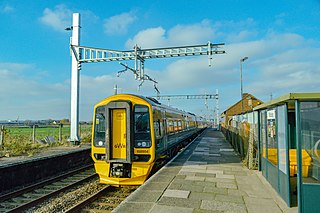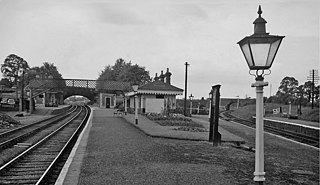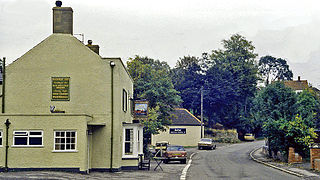
Bristol Temple Meads is the oldest and largest railway station in Bristol, England. It is an important transport hub for public transport in the city. In addition to the train services there are bus services to many parts of the city and surrounding districts, and a ferry to the city centre. Bristol's other major station, Bristol Parkway, is on the northern outskirts of the conurbation.

Gloucester railway station is a railway station serving the city of Gloucester in England. The station was originally built as the terminus of the Birmingham and Gloucester Railway in 1840, but the arrival of the Bristol and Gloucester Railway and Cheltenham and Great Western Union Railway in 1844, and then conversion to a through station for the South Wales Railway in 1851 resulted in a very complex layout. Subsequent closures and rationalization have left Gloucester with a station that is located off the main Bristol-Birmingham line, meaning trains that call at Gloucester must reverse except for trains that continue along the Gloucester to Newport Line.

Pilning railway station is a minor station on the South Wales Main Line near Pilning, South Gloucestershire, England. It is 10 miles (16 km) from Bristol Temple Meads and is the last station on the English side before the Severn Tunnel through to Wales. Its three letter station code is PIL. It is managed by Great Western Railway, who provide the two train services per week from the station.

Cam and Dursley railway station is a railway station serving the village of Cam and the town of Dursley in Gloucestershire, England. It is located on the main Bristol-Birmingham line, between Yate and Gloucester, at a site close to where Coaley Junction railway station was situated from 1856 to 1965.

Filton Abbey Wood railway station serves the town of Filton in South Gloucestershire, England, inside the Bristol conurbation. It is 4.4 miles (7.1 km) from Bristol Temple Meads. Its three letter station code is FIT. There are four platforms but minimal facilities. The station is managed by Great Western Railway, the seventh company to be responsible for the station, and the third franchise since privatisation in 1997. They provide most train services at the station, with two trains per day operated by CrossCountry. The general service level is eight trains per hour - two to South Wales, two to Bristol Parkway, two toward Weston-super-Mare and two toward Westbury.
The Bristol and Gloucester Railway was a railway company opened in 1844 between the cities in its name. It was built on the 7 ftBrunel gauge, but it was acquired in 1845 by the 4 ft 8 1⁄2 instandard gauge Midland Railway, which also acquired the Birmingham and Gloucester Railway at the same time.

Patchway railway station is on the South Wales Main Line, serving the Bristol suburbs of Patchway and Stoke Gifford in South Gloucestershire, England. It is 6 miles (10 km) from Bristol Temple Meads. Its three letter station code is PWY. It is managed by Great Western Railway, who provide all train services at the station, mainly a train every hour in each direction between Cardiff Central and Taunton.

Yate railway station serves the town of Yate in South Gloucestershire, in south west England. The station is located on the main Bristol to Birmingham line between Bristol Parkway and Cam & Dursley, and is operated by Great Western Railway.

The Henbury Loop Line, also known as the Filton to Avonmouth Line is a railway line following the boundary between Bristol and South Gloucestershire between the Severn Beach Line at Hallen Marsh Junction, Avonmouth and the Cross Country Route/South Wales Main Line at Filton. It is currently only used for freight.

Mangotsfield railway station was a railway station on the Midland Railway route between Bristol and Birmingham, 5.1 miles (8.2 km) north-east of Bristol Temple Meads and 82 miles (132 km) from Birmingham New Street, serving what is now the Bristol suburb of Mangotsfield. The station was opened in 1845 by the Bristol and Gloucester Railway, but had very little in the way of passenger amenities. The station was resited in 1869 to serve the new Mangotsfield and Bath Branch Line, and became an important junction station with extensive facilities and six platforms. Passenger footfall however failed to match the station's size, though at its peak eight staff were employed. The station closed in 1966 when services to Bath ended as part of the Beeching cuts, and the line through the station closed in 1969. The railway became a cycle path in the 1980s, and is a popular resting point on the route as several of the station's walls and platforms are still in situ.
The Mangotsfield and Bath branch line was a railway line opened by the Midland Railway Company in 1869 to connect Bath to its network at Mangotsfield, on its line between Bristol and Birmingham. It was usually referred to as "the Bath branch" of the Midland Railway.

Iron Acton station opened on 2 September 1872, with the start of services on the Midland Railway branch from Yate to Thornbury. The station was designed by the Midland Railway company architect John Holloway Sanders.

Foss Cross railway station was on the Midland and South Western Junction Railway in Gloucestershire. The station opened on 1 August 1891 with the section of the line between Cirencester Watermoor and the junction at Andoversford with the Great Western Railway's Cheltenham Lansdown to Banbury line, which had opened in 1881.
Nailsworth railway station served the town of Nailsworth in Gloucestershire, England and was the terminus of the 9.3 km-long Stonehouse and Nailsworth Railway, later part of the Midland Railway.

Berkeley Road railway station served the towns of Berkeley and Dursley in Gloucestershire, England.

Tytherington railway station served the village of Tytherington in South Gloucestershire. The station was on the Yate to Thornbury branch line that was opened by the Midland Railway in 1872. The station was designed by the Midland Railway company architect John Holloway Sanders.

Dursley railway station served the town of Dursley in Gloucestershire, England, and was the terminus of the short Dursley and Midland Junction Railway line which linked the town to the Midland Railway's Bristol to Gloucester line at Coaley Junction.

Cam railway station served the village of Cam in Gloucestershire, England. The station was on the short Dursley and Midland Junction Railway line which linked the town of Dursley to the Midland Railway's Bristol to Gloucester line at Coaley Junction.

The Thornbury branch line is a railway line from Yate to Thornbury in the West of England. From 1963 until mid 2013, it remained as a freight route, serving the quarry at Tytherington. It was designated 'Out of Use (temporary)' by Network Rail from 2013 until 2017, when it reopened to serve Tytherington quarry again. The 7.5-mile (12 km) branch of the Midland Railway line between Bristol and Gloucester opened on 2 September 1872, and started at Yate and finished at Thornbury, with stops at Iron Acton and Tytherington.
The Badminton railway line is a railway line opened in 1903 by the Great Western Railway between Wootton Bassett in Wiltshire and Patchway and Filton, north of Bristol, England. Forming the eastern section of the South Wales Main Line, it shortened the distance between South Wales and London for heavy mineral traffic and for express passenger trains, and relieved congestion on the line through Bath.















